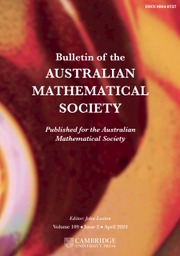No CrossRef data available.
Article contents
A characterisation of reflexive modules
Published online by Cambridge University Press: 17 April 2009
Abstract
Core share and HTML view are not available for this content. However, as you have access to this content, a full PDF is available via the ‘Save PDF’ action button.
We characterise reflexive modules over the rings R such that each finitely generated submodule of E(RR) is torsionless (left QF-3″ rings) by means of a suitable linear compactness condition relative to the Lambek torsion theory.
- Type
- Research Article
- Information
- Copyright
- Copyright © Australian Mathematical Society 1996
References
[1]Pardo, J.L. Gómez and Asensio, P.A. Guil, ‘Morita dualities associated with the R-dual functors’, J. Pure Appl. Algebra 93 (1994), 179–194.CrossRefGoogle Scholar
[2]Pardo, J.L. Gómez and Asensio, P.A. Guil, ‘Reflexive modules over QF-3′ rings’, Tsukuba J. Math 19 (1995), 387–395.Google Scholar
[4]Hoshino, M. and Takashima, S., ‘On Lambek torsion theories, II’, Osaka J. Math. 31 (1994), 729–746.Google Scholar
[6]Masaike, K., ‘Duality for quotient modules and a characterization of reflexive modules’, J. Pure Appl. Algebra 28 (1983), 265–277.CrossRefGoogle Scholar
[7]Masaike, K., ‘Reflexive modules over QF-3 rings’, Canad. Math. Bull. 35 (1992), 247–251.Google Scholar
[8]Müller, B.J., ‘Linear compactness and Morita duality’, J. Algebra 16 (1970), 60–66.Google Scholar
[9]Stenström, B., Rings of quotients (Springer-Verlag, Berlin, Heidelberg, New York, 1975).Google Scholar


